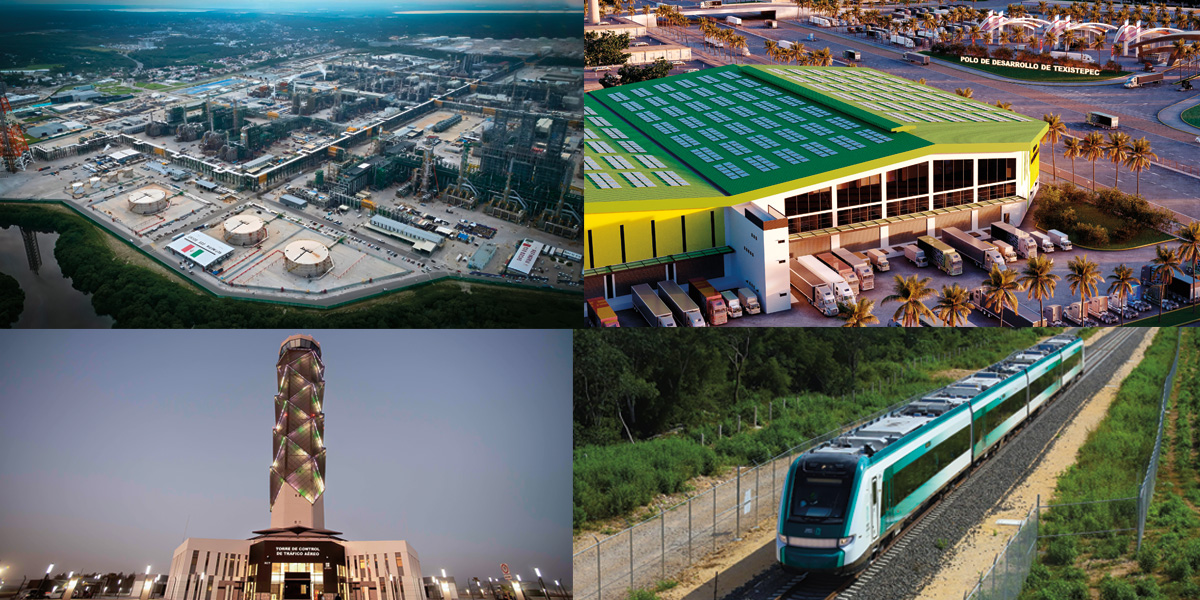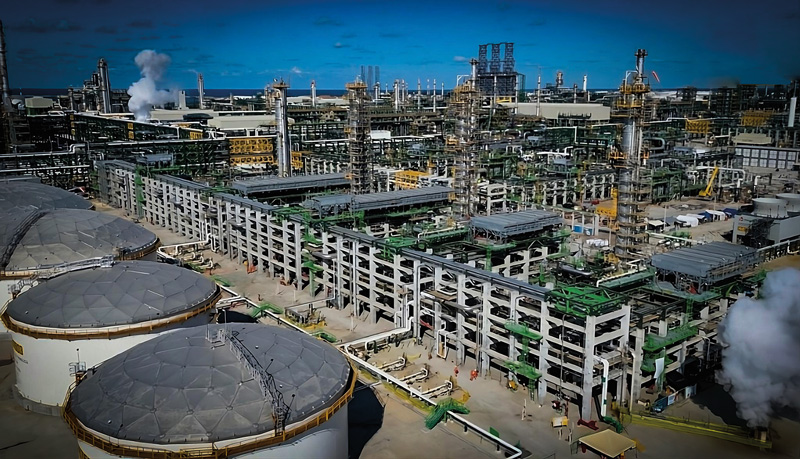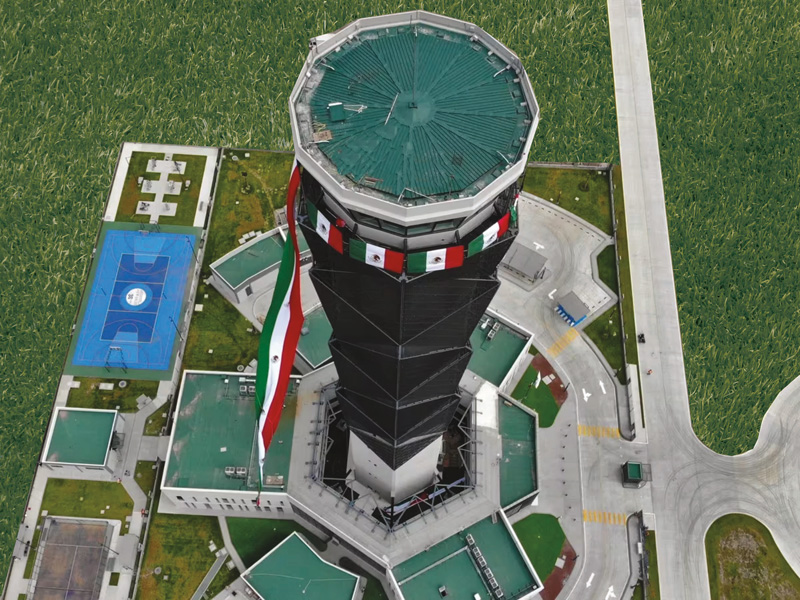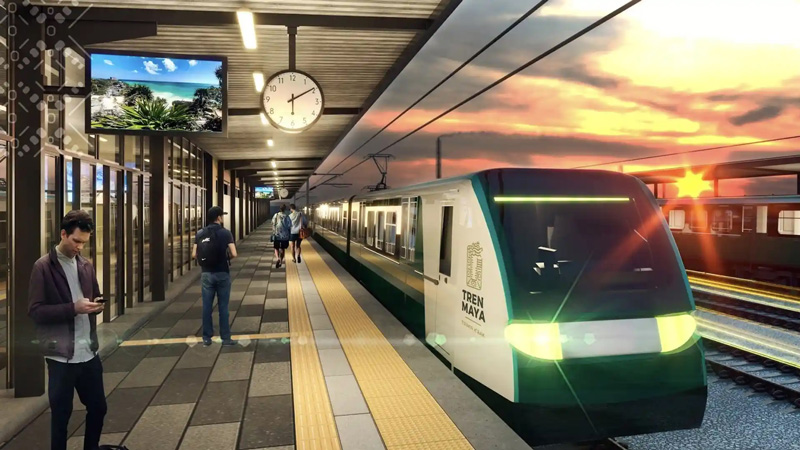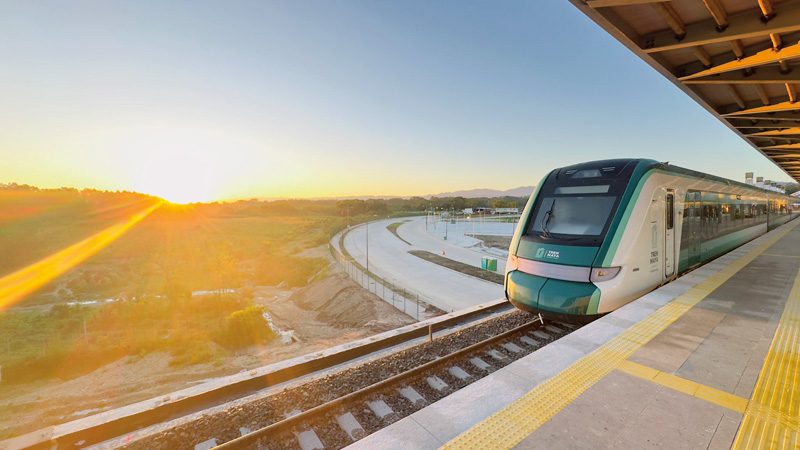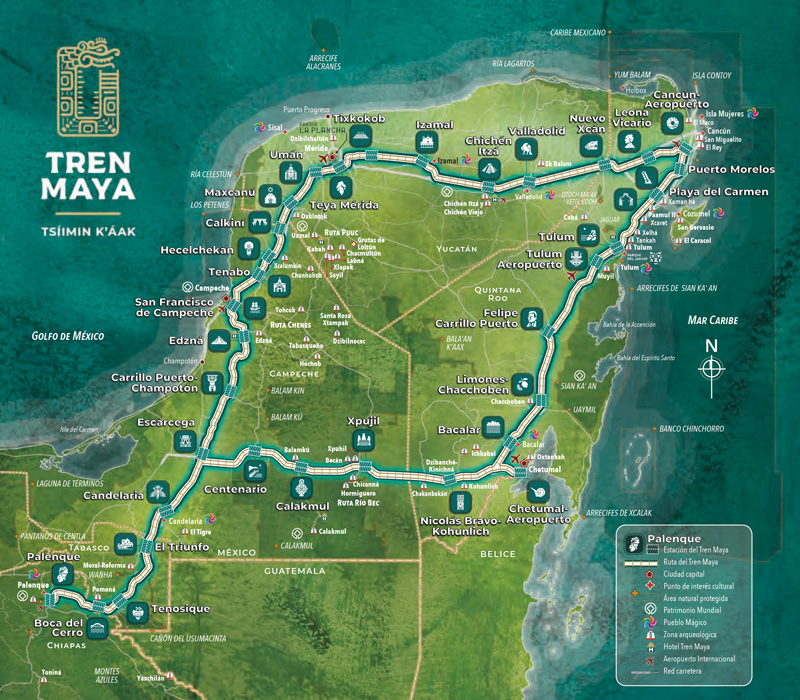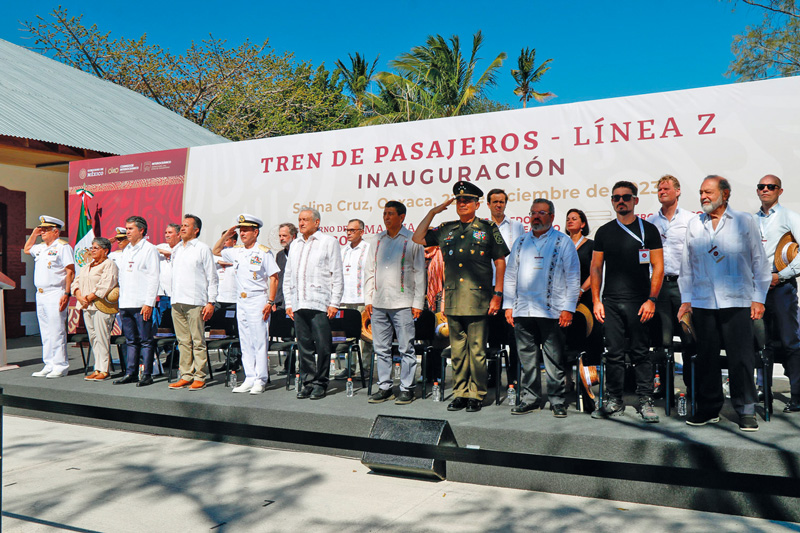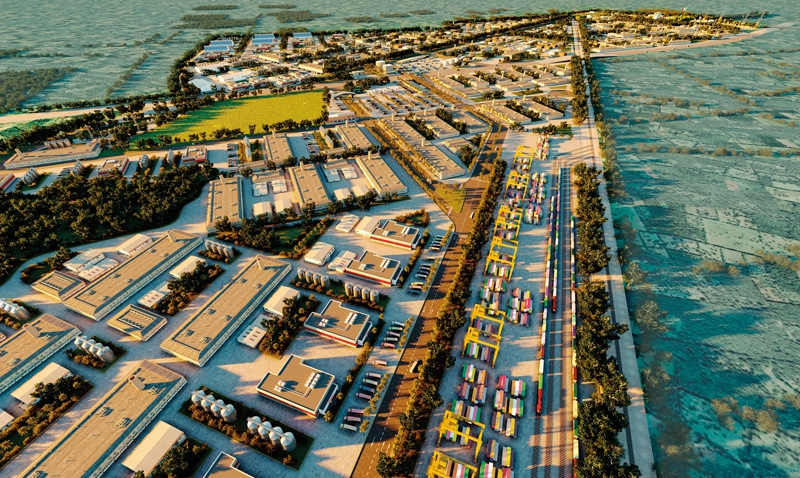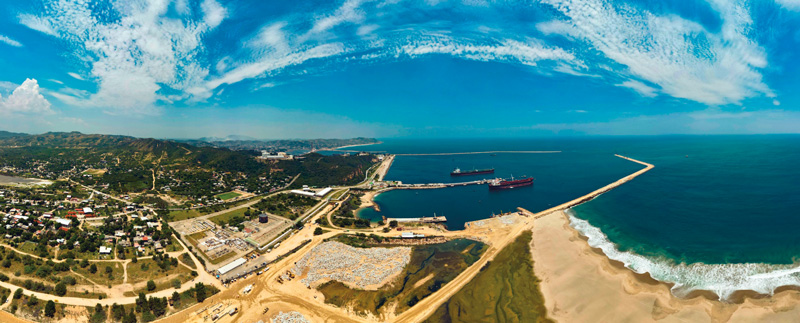The construction of these mentioned works has generated thousands of direct and indirect jobs, especially in the southeastern, benefiting primarily the population of the states of Chiapas, Tabasco, Yucatán, Quintana Roo, Campeche, Oaxaca, and Veracruz, along with additional benefits such as the development of goods, services, procurement of materials, and infrastructure development..
1. OLMECA REFINERY IN DOS BOCAS, TABASCO
The main objective of the Olmeca Refinery in Dos Bocas, located on a 586-hectare property owned by Pemex and the Federal Government in the municipality of Paraíso, Tabasco, is to enhance energy security by increasing gasoline and diesel production, aiming for self-sufficiency. At the same time, the goal is to increase the production of higher value-added products, balance the trade, and promote economic and social development of the Southeastern region of Mexico.
Currently, Mexico imports nearly 80% of the fuels it consumes, incurring higher costs for consumers. The plan is to produce more gasoline, modernize the country's six refineries and add Dos Bocas to reduce fuel costs. Dos Bocas has the capacity to process 340 thousand barrels per day, receiving one million 100 thousand barrels of oil, resulting in significant savings in distribution logistics. It is expected to produce 170 thousand barrels of gasoline and 120 thousand barrels of ultra-low sulfur diesel.
Dos Bocas was chosen between Tuxpan and Coatzacoalcos because it is the location where oil pipelines—the raw material—arrive from the coast of Tabasco and the Campeche Sound, extracting 80% of hydrocarbons in Mexico. The project meets conditions to safeguard the environmental assets of individuals and communities, endorsed by the Agency for Safety, Energy, and the Environment (ASEA).
The massive project has been approved by the National Autonomous University of Mexico (UNAM), the Federal Electricity Commission (CFE), the Mexican Petroleum Institute (IMP), Petróleos Mexicanos (Pemex) and other specialized companies for geological, soil mechanics, seismic, environmental, social and other studies.
During the refinery's opening on July 1, 2022 - the 71st commitment of his administration - López Obrador said, "It is a dream come true. Imagine, we were selling crude oil and buying gasoline, that is what is changing now, it is a conversion, a turn, we are not going to sell crude oil anymore, we are going to process all our raw material to produce gasoline and diesel."
In the inaugural ceremony, then-Secretary of Energy Rocío Nahle pointed out that the project was divided into six packages, including the construction of 17 chemical process plants. These plants include the combined plant, a coker; hydroprocessing plants for gas oils, diesel, and naphthas; reforming, catalytic, and alkylation plants; isomerization of butanes and pentanes; residual gas treatment plant; hydrogen; sulfur; sour water regeneration; amines regeneration; cogeneration; and water and effluent treatment plant.
Nahle García pointed out that this grand project consists of 90 storage tanks, 56 of which are vertical for liquid storage and 34 spheres for gas, with a storage capacity of 15 million barrels. Additionally, it includes integration and administrative areas, as well as a cogeneration system to produce its own electricity of 280 MW and the necessary steam for operation.
In addition, she reported that on the entire site, 30,214 piles and 55,435 inclusions were built with 969,535 m³ of concrete and 74,214 tons of rebar, equivalent to the concrete of 23 Azteca stadiums and the steel of ten Eiffel Towers.
2. FELIPE ÁNGELES INTERNATIONAL AIRPORT
The Felipe Ángeles International Airport (AIFA) is built on a 3,800-hectare plot, the former location of the Military Air Base No. 1 of the Mexican Air Force, inaugurated in 1952, in what was the San Lucía Hacienda, founded in 1576.
Previously, Military Air Base No. 1, then called Balbuena Military Air Field, was located in the Balbuena neighborhood of Mexico City.
The objective of AIFA is to reduce the high saturation of the Mexico City International Airport (AICM), to provide medium and long-term attention to air services in the Valley of Mexico; to improve the connectivity of the National Airport System; to increase operational efficiency, service quality, and airport connectivity; and to strengthen regional and national economic competitiveness.
The Secretary of National Defense, General Luis Cresencio Sandoval, emphasized that AIFA would contribute to Mexico's economic development. He noted that entrusting the Armed Forces with the construction of the new metropolitan airport was not a coincidence but based on their decades-long proven experience in projects such as hospitals, rehabilitation centers, medical units, housing complexes, educational institutions, among others.
On the other hand, General Isidoro Pastor, general director of AIFA, acknowledged that "this day is momentous for our country, as the civil aviation industry, nationally and internationally, incorporates an airport that will be able to compete with the best in the world due to its technological modernity, design, and sustainability." He highlighted that with the operation of AIFA, in addition to generating an average of 5,000 direct jobs and 160,000 indirect jobs, according to the institutional program of this airport, it will have the capacity to serve a demand of 20 millions passengers in its first phase, 40 million in the second phase and by the year 2052 it will serve an average of 90 millions per year.
Inaugurated on March 21, 2022, with eight flights, including one international, it was expected to serve 2.5 million passengers in the following 12 months and increase to 5 million the following year.
AIFA is composed of two main parts: a military city, where the military air base is located, and the international airport, with three runways—two of them 4.5 km long for commercial use and one 3.5 km long for military operations by the Mexican Air Force, explains Gustavo Vallejo, resident general engineer and commander of the "Felipe Ángeles" engineering group. In addition to the 88-meter tall main control tower and the four-story passenger terminal building, the airport includes an airport services area, international and domestic air cargo, main maintenance supply, airport fuel terminal, convention centers, and other facilities.
The Santa Lucia Paleontological Museum "Quinametzin" will exhibit the large number of mammoth bones and other species that inhabited the Santa Lucia area during the late Pleistocene period; the Military Aviation Museum "MUMA" will exhibit the history of aviation in the Mexican Air Force and the Historical Cultural Train dating back to the Mexican Revolution.
On this occasion, the President of the Republic said that the AIFA is a first-class asset of the nation, made possible by the sum of wills. "It is finished, you can now get to the airport from any part of the city (...) and it will be given to the people of Mexico because it is a work of the people, built by workers and for the benefit of the nation," he said.
To facilitate the connection to the AIFA, the Ministry of Infrastructure, Communications and Transportation (SICT) is building a system of interconnected roads that includes three highways, a 6-kilometer main road and is working on a connection to the suburban train that will go from Buenavista to the airport.
3. Tren Maya
The Mayan Train is a new rail service that connects the main cities and tourist areas of the Yucatán Peninsula. It is a project that will strengthen the territorial planning of the region and boost its tourism industry. It will generate economic benefits by increasing job opportunities and enhancing connectivity in the Yucatán Peninsula, allowing for the efficient movement of cargo and passengers.
The proposal prioritizes environmental care through Environmental Impact Statements, where there are no existing rail lines, and will implement compensation and mitigation measures to safeguard the environmental and cultural heritage of the area.
It will connect the Maya world in five states of southeastern Mexico, which will reduce transport times and costs for goods, passengers, and tourists within the peninsula.
Approximately 1,554 kilometers of railway tracks are being constructed, traversing the states of Tabasco, Chiapas, Campeche, Yucatán, and Quintana Roo, benefiting regional development and the quality of life of inhabitants
Furthermore, it will facilitate connectivity between communities, improve quality of life, and boost the economy of the southeast. It will offer transportation services for passengers, tourists, and cargo more effectively and efficiently. It will help alleviate vehicular traffic on roads by reducing pollutant emissions. Its 16 stations will connect communities to create centers of development by fostering trade and sustainable tourism.
The inauguration of the first stage from Campeche to Cancún – sections 2, 3, and 4, corresponding to the San Francisco Campeche station to Cancún Airport, a route of 473 kilometers – by President López Obrador took place at the San Francisco Campeche station on December 15, 2023. "It is a grand project; we are not exaggerating if we say that there is no project like this currently in the world. It is a work of the Mexican people, and that is why we will all take care of it. It is a work of all Mexicans to greatly aid the development of the southeast," commented the president. He emphasized that it represents a unique project in the world, achieved in record time of less than five years, thanks to the work of thousands of construction workers, the grouping of Military Engineers of the National Defense Secretariat, and participating companies: ICA, Grupo Carso, Azvindi Ferroviario, Mota-Engil, and Alstom.
"In this project, almost 100,000 construction workers have been hired from all over the country, specialized workers, ironworkers, welders, among the best in the world; that is a comparative advantage compared to other countries. Mexican construction workers are among the best in the world," stated López Obrador.
One of the purposes of the Maya Train, the president explained, is to promote domestic and foreign tourism by connecting the ancient archaeological cities and exalting the cultural greatness of the region, which has been forgotten for decades. "It is about connecting the ancient Mayan cities, but if that were not enough, where else can you find the native flora and fauna found in this region? Only the Amazon, nothing else, and in native species, there is something unique, exceptional in this entire region that is not known, add to that the beaches of the Gulf, the Caribbean, and the brotherhood, hospitality, and nobility of the people; it is a paradise, that is the most important thing," he added.
In Campeche, he explained, tourism is the best long-term alternative for the development and economic growth of the southeast. "I look forward, 20 years ahead, I see tourism as the spearhead of development, not just growth, but development – which is much more than growth – I see tourism for the southeast. Remember that there are countries that live off of that or have significant income from tourism development, that's why this project will help a lot," he noted.
The Maya Train will consist of 42 trains built in Mexico. The exterior design of the wagons is inspired by Mayan culture and the jaguar, an endemic animal of the southeast.
The journey to the destinations will be made aboard three models:
- Xiinbal, which means journey or ride in Mayan, is the standard service train that provides users with a pleasant and tranquil journey. It features panoramic windows that allow visitors to enjoy the green landscapes of the southeast.
- Janal –meaning eat, in the local language–, is a train for gastronomy and tourism enthusiasts. The restaurant concept was inspired by the work of Mexican architect Luis Barragán, who was passionate about aesthetics and nature.
- P'atal, from the Mayan word P'atal, which means stay or remain, is a train designed for long distances, allowing travelers to journey in comfortable reclining seats or cabins where they can relax until their destination.
Oscar David Lozano Águila, General Director of the Maya Train, reported that the work performed represents the installation of 1,846 kilometers of rails; 1.6 million sleepers; operation of 7,550 machines; 3,620 kilometers of pipelines; thousands of welds, and over 69 million cubic meters of earth to build the railway through Campeche, Yucatán, and Quintana Roo.
He pointed out that, as part of the Program for the Improvement of Archaeological Zones (Promeza), the National Institute of Anthropology and History (INAH) recovered 12 archaeological sites along the route and is constructing five Visitor Assistance Centers (Catvi).
The recovery of archaeological heritage on this stretch involved the work of archaeologists, anthropologists, specialists, and workers who helped recover 13,801 buildings, 624,522 ceramic fragments, and 427 natural features.
He added that, within the environmental commitment of the Maya Train, the Protected Natural Areas along its route represent 510,690 hectares, and he emphasized that, thanks to programs such as the Monitoring of Groundwater and Surface Water Bodies and the Prevention and Mitigation Program for Ecological Damages and Risks, the entire hydrological system of the cenote ring can be preserved.
In addition, 83 works have been carried out as a result of the social commitment, and for next year it has been announced that a program will be launched, with the support of the SICT, to rehabilitate roads for the benefit of the communities and towns through which the trucks and construction machinery have passed.
4. INTEROCEANIC CORRIDOR OF THE ISTHMUS OF TEHUANTEPEC
The Interoceanic Corridor of the Isthmus of Tehuantepec (CIIT) is a logistics platform integrated by port services and connected by the Isthmus of Tehuantepec Railway and the National Highway System. Together with the creation of development poles, it will strengthen industrial activity and offer a modern and efficient alternative for regional and global trade.
Taking advantage of the strategic location of the Isthmus of Tehuantepec, in the narrowest space in North America, the CIIT is creating a multimodal logistics platform linking the Pacific and Atlantic Oceans. These actions promote the development of Southern Mexico with an integral, sustainable and inclusive vision.
The logistics platform integrates the ports of Salina Cruz, Coatzacoalcos, Dos Bocas and Puerto Chiapas, with access to the southern United States, Europe, the Americas and Asia, are the points of connection between the Pacific and Atlantic Oceans, facilitating trade at the national and international levels. Connected to a network of more than 1,200 kilometers of railroads, highways and airports, they optimize logistics, generate opportunities and strengthen the region's strategic position in the world.
The Isthmus of Tehuantepec Railroad has rail lines that connect the states of Chiapas, Oaxaca, Tabasco and Veracruz, facilitating the transportation of freight, inter-oceanic transit and the exit of local production, also incorporating passenger services, offering an integral connectivity. It is connected to the national rail network, the Mayan Train, North America and Central America, which promotes economic development and regional logistical efficiency.
Along the railroad tracks that connect the Pacific Ocean with the Atlantic Ocean, 10 Development Poles for Well-being (PODEVIS) will be distributed, which will have ideal conditions for investments, the installation of industries and will boost the productive capacities of the region. Among the vocations of the poles are the electrical and electronics, automotive, auto parts and transport equipment, agribusiness, medical devices, pharmaceutical and petrochemical industries, among others.
At the inauguration of this great work, President López Obrador said that this project has been dreamed of for centuries by authorities, kings, politicians and rulers. "Since the Spanish invasion, Charles V asked Hernán Cortés to look for a passage to connect the two oceans; Napoleon was interested; Baron Humboldt, a German scientist, studied all the steps to connect the oceans, nine, and finally defined three: Panama, Nicaragua and the Isthmus of Tehuantepec, and he said that this was the best step.
"However, as you know the history, the Panama Canal was built, but at the same time this passage was carried out to connect the Gulf with the Pacific; the port of Coatzacoalcos was built, the port of Veracruz and the railroad that was inaugurated in 1907, seven years before the first ship passed through the Panama Canal, this route had already been inaugurated".
The president concluded by commenting that at that time the plan did not prosper enough because Asia was not what it is now and it was abandoned as an option. "Times have changed and now it is a strategic project; I went to San Francisco, to the Asia-Pacific meeting, we presented this project and everybody is interested".
Text:Ricardo Villanueva
Photo: Refinería Olmeca Dos Bocas / Kiryl Balbatunou / EL CIUDADANO / LA RAZÓN / arcpublishimng / idom. / de raiz

